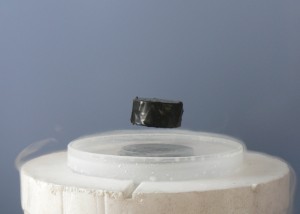Archive for the ‘Science News’ Category
Iron-Based Superconductor Breakthroughs
Research from Cornell University confirms the theory about how electrons pair up and move through the superconductor without interference. You can read the original article here. The way electrons move through the superconductor is, of course, key to the way the superconductor allows a current to pass without resistance.
The development of a room temperature superconductor is one of the Holy Grails of condensed matter physics. Until 1986, it was believed that superconductivity was limited to temperatures below 30 degrees Kelvin (-243 degrees Celsius). Thanks to work at IBM, we’ve since seen the development of high-temperature superconductors (don’t get too excited – the “high temperature” gets up to -163 degrees Celsius). Any research that helps us to understand how superconductors work will lead us closer to the development of superconductors that do not require extraordinary conditions to function.
Why are we interested in superconductors anyway? Well, superficially it’s because of phenomena like this:
That’s not a magic trick, folks – it’s a magnet levitating over a superconductor. If you haven’t seen this before, I’m afraid you’re way behind the times. We’re already using superconductors all over the place. They’re the most powerful electromagnets we know about, and can be found in MRIs and particle accelerators, for instance. Maybe you heard that the Large Hadron Collider at CERN has to be cooled to near-absolute zero temperatures to function. Well, that’s because the cold temperatures are required to keep the LHC’s superconductors working as required.
I’m not so interested in superconductors for particle accelerators, though. Rather, it’s what they could do for our power grid and trains that has my attention. Practically everything to do with the transmission of power will be revolutionized by superconductivity, because there would be no (or close to no) inefficiency in the system. Right now, a lot of energy is lost en-route and dispelled in the form of heat. In fact, if you have anything electrical that generates heat when that’s not part of its function, you know that’s all wasted energy. Superconductors will help to cut down on that waste.
I’ve had a love of trains ever since I was a kid, and it saddens me to see the rest of the world progressing in locomotive technology while we remain in a nineteenth century stasis. I hope that breakthroughs in superconductivity will eventually help to snap us out of that, and make upgrading the nation’s rail systems a profitable endeavor.
So, there’s a lot riding on experiments like this one done at Cornell.
Dino Flatulence Caused Climate Change?
You can see the original article here from The Telegraph.
Summary
The takeaway is that the dinosaurs, like the cows of today, would have produced a substantial amount of methane. Unlike our cows, though, the dinosaurs were huge, ranging in length up to 150 feet and in weight over 45 tonnes. The research suggests that dino-produced methane would have been around 472 million tonnes per year, compared to the (comparatively) recent pre-industrial average of 181 million tonnes per year. Incidentally, the article suggests that man-made emissions now match dinosaur flatulence and . . . I’ll leave you to make the obvious jokes about that one (if you have any good ones, feel free to comment!).
Thoughts
I don’t want people to get the wrong idea – this is not directly related to the extinction of the dinosaurs. They didn’t warm the Earth so much that they ended up undermining their own ecology. Instead, the extra warmth actually helped them, creating a stable equilibrium. The climate we evolved in is not rich enough to sustain creatures as large as the dinosaurs. In a warmer climate, though, the available zones for rainforests and other foliage-rich regions would have been broader, and the extent of unproductive arctic ice narrower. In other words, the fact that dinosaurs emitted extra methane led to a virtuous cycle that increased their own potential size (up to a certain limit, of course).
There was a downside, though. Their size made them dependent on the high productivity of the land. That meant that even a minor change in the climate produced by the extinction event would have led to a marginal reduction in the sustainability of the dinosaur population. Say the climate changed enough to reduce the food supply by only two to three percent. Well, that means two to three percent less methane emissions, and therefore a further cooling of the atmosphere. As the atmosphere cooled more, a downward spiral would have ensued, leading to the extinction of the dinosaurs. So, even though their flatulence was actually beneficial to them, it may have also set up the particular nature of their downfall.
Will the seeds of our success as a species do the same?
NASA’s NuSTAR Black Hole Hunter
NASA’s Jet Propulsion Lab just posted this video introducing the Nuclear Spectroscopic Telescope Array (NuSTAR) X-Ray telescope. This is a purely non-technical (public-friendly) presentation, so I’ll try and get more detailed information about the project. Personally, I’m more interested in the launch method, which is an L-1011 carrying one of Burt Rutan’s Pegasus rockets.
Just a thought: NASA really needs to do a better job of explaining to the public why the information we might get from black hole research might be valuable. They certainly don’t make that clear in this video, and I worry that they risk facing more budget cuts if they don’t grab the public’s attention a bit more compellingly.
The project was supposed to launch on March 21st, but has been delayed, and they’re looking at a possible June launch. Apparently, the delay was due to software problems with the launch vehicle.
